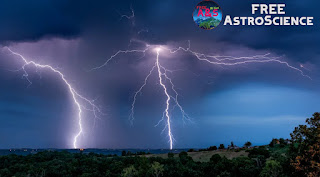Have you ever wondered about the science behind those awe-inspiring flashes in the sky during a thunderstorm? At FreeAstroScience.com, we're excited to take you on a journey through the electrifying world of lightning strikes. From the different types of lightning to their potential dangers and crucial safety measures, we promise to illuminate this fascinating natural phenomenon in a way that will leave you both informed and captivated.
Lightning Strikes: Unraveling Nature's Electric Show
The Spark of Creation: How Lightning Forms
Let's start by understanding how these spectacular light shows come to be. Lightning is essentially a massive electrical discharge that occurs when there's an imbalance between positive and negative charges within a cloud or between a cloud and the ground.
Here's how it typically unfolds:
- As warm air rises in a thundercloud, it carries water droplets upward.
- These droplets collide with super-cooled water droplets and ice crystals.
- These collisions create a separation of electrical charges.
- The upper part of the cloud becomes positively charged, while the lower part becomes negatively charged.
- When the difference between these charges becomes great enough, an electrical discharge occurs - that's our lightning!
Types of Lightning: A Shocking Variety
We at FreeAstroScience.com find it fascinating that not all lightning is created equal. Let's explore the main types:
Cloud-to-Ground (CG) Lightning: This is what most of us think of when we picture lightning. It can be either negative (-CG) or positive (+CG), with negative being more common.
Intra-Cloud (IC) Lightning: Also known as sheet lightning, this occurs entirely within a cloud and is the most common type.
Cloud-to-Air (CA) Lightning: This type jumps from a cloud into clear air, often creating spectacular visual displays.
Cloud-to-Cloud Lightning: As the name suggests, this occurs between two separate clouds.
Ground-to-Cloud (GC) Lightning: Less common, this type initiates from tall structures on the ground and moves upward.
Ball Lightning: A rare and mysterious form of lightning that appears as glowing, electric orbs.
When Lightning Strikes: Impact on the Human Body
While beautiful from afar, lightning can be incredibly dangerous up close. When a person is struck by lightning, the effects can be severe and wide-ranging:
- Cardiac Arrest: The electrical current can disrupt the heart's natural rhythm.
- Respiratory Failure: The strike can paralyze the respiratory system.
- Burns: Both external and internal burns are common.
- Neurological Damage: This can lead to memory issues, chronic pain, and mood disturbances.
- Blunt Trauma: The shock wave from a nearby strike can cause injuries similar to an explosion.
Staying Safe: Lightning Protection Measures
At FreeAstroScience.com, we believe knowledge is power, especially when it comes to safety. Here are some crucial tips to remember during a thunderstorm:
- Seek shelter in a fully enclosed building or a hard-topped vehicle.
- Stay away from windows, electrical equipment, and plumbing when indoors.
- Avoid open areas, tall objects, and bodies of water when outdoors.
- Wait 30 minutes after the last thunder before resuming outdoor activities.
- If caught outside, adopt the 'lightning position': squat with your feet close together, head tucked, and ears covered.
Remember, no place outside is completely safe during a thunderstorm. The best protection is to be inside a sturdy building or vehicle.
Conclusion: As we've explored at FreeAstroScience.com, lightning is a complex and fascinating natural phenomenon. From the various types of strikes to their potential impacts on the human body, understanding lightning can help us appreciate its power and respect its dangers. By following proper safety measures, we can enjoy the beauty of these electrical displays from a safe distance. The next time you see a flash in the sky, you'll have a deeper understanding of the incredible forces at work. Stay curious, stay safe, and keep exploring the wonders of our natural world with us!


Post a Comment